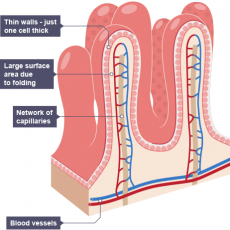

Exchange Surfaces and Transport
All cells must be able to exchange products across exchange surfaces in order to function. The absorption of oxygen and glucose and the removal of carbon dioxide and urea are vital aspects to specialised exchange. If this could not happen then cells would eventually die. The ease of exchange will depend on features of the exchange surface such as length, thickness and what it is composed of.
First important fact to recognise: smaller animals have a higher surface area to volume ratio (written as surface area: volume or SA: ratio) than larger animals.
How so?
Think of a hamster and compare it to an elephant. The surface area is the sum of all the surface. Although the elephant has a larger surface area than the hamster, we have to consider volume as well. For example, the hamster may have a surface area of 6 cm2
(not accurate) and the elephant may have a surface area of 64cm2. The volume of the hamster is 1cm3 and the volume of the elephant is 32 cm3 .
The surface area to volume ratios are therefore:
Hamster: 6: 1
Elephant: 64:32 or 2:1
Therefore, the hamster has the larger surface area to volume ratio.
Single celled organisms are rather small and so substances can be transferred through direct diffusion into or out of a cell. But for larger organisms the diffusion rate is too slow because of the large distances to travel. Diffusion is also insufficient because some cells are deep within an organism. Imagine trying to get a substance from your skin cells to the centre of your stomach, that’s a long distance to travel in terms of travelling through many cells…
Efficient exchange by diffusion requires a large surface area to volume ratio, as we just established, larger animals have smaller surface area to volume ratios. It would be difficult to exchange to such a large volume with an insufficient surface area. Multicellular organisms are also very demanding with such a high metabolic rate, diffusion would never supply to the vast set of demands required for correct cell functioning. Thus, there is a need for specialised transport systems and exchange surfaces.
What are the features of specialised exchange surfaces?
You might have guess it but… a large surface area. More surface means more room for exchange. Root hair cells are an excellent example of specialised exchange surfaces. Have a look at their shape, the peculiar shape allows for more surface to be exposed. This will increase the amount of absorption of water and mineral ions.
If Usain Bolt has a 200m race and 100cm race, which one will he finish in a quicker amount of time? Similarly, if a cell is 5cm thick, and another is 1cm thick, which would oxygen travel faster through? Thus, gas exchange surfaces that are thin are more efficient for gas exchange.
Exchange surfaces rely on good blood supply and ventilation. It’s all well and good the surface being sufficient, but a great supply is needed to match demands.
Image: http://www.bbc.co.uk/schools/gcsebitesize/science/triple_aqa/movement_of_molecules/dissolved_substances/revision/4/

0 Comment:
Be the first one to comment on this article.